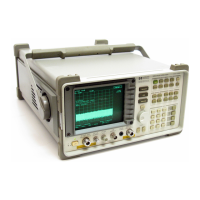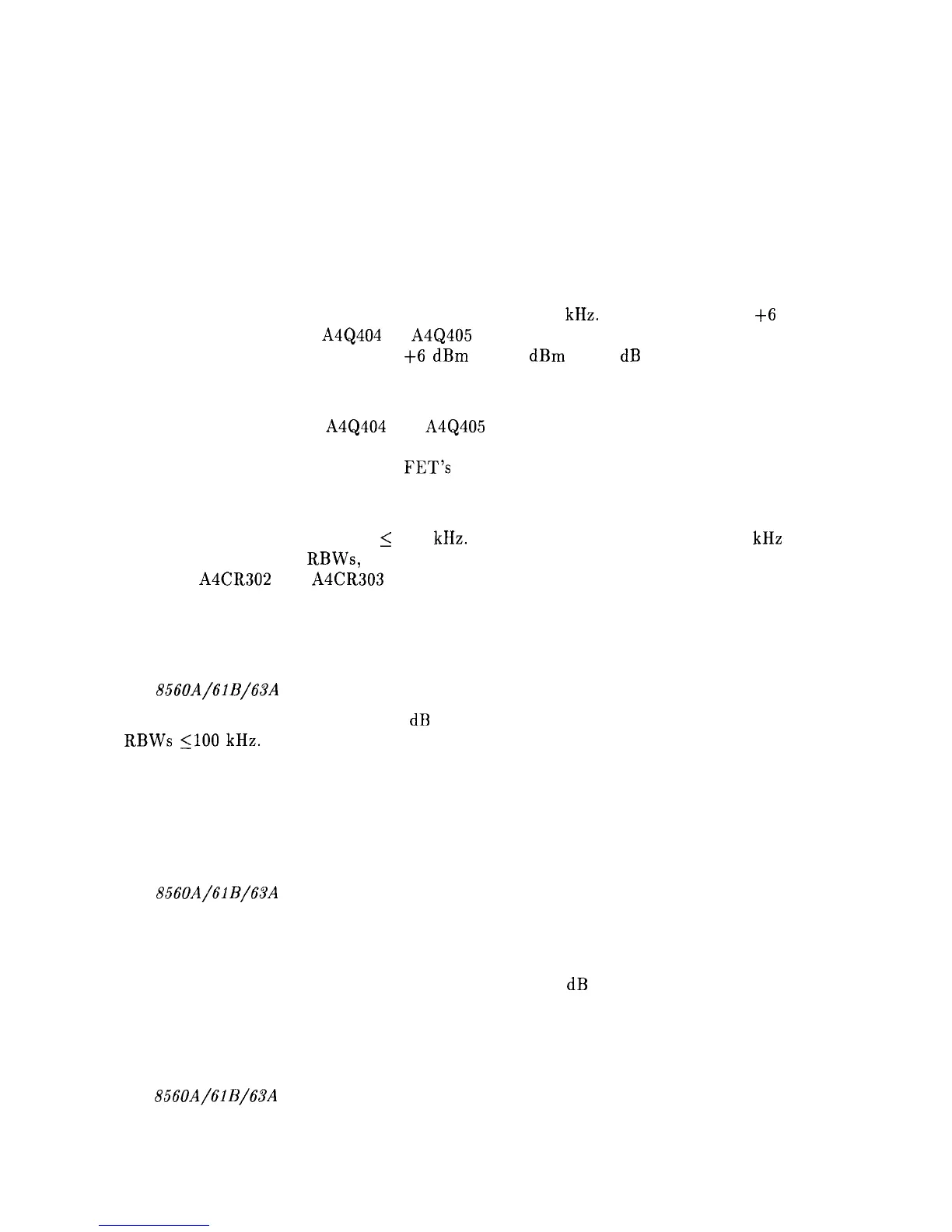Synchronous Detector
A wide dynamic range linear detector is realized by the Limiter (block G), the Isolation
Amplifier (block H), the LO Amplifier (block I),
and the Detector/Mixer (block J). The
combination of these circuits form what is commonly known as a synchronous detector.
The input signal is split between two paths. One path flows through the Isolation Amplifier
and the other path flows through the Limiter and LO Amplifier The path flowing through
the limiter generates the LO for the Detector/Mixer block. The path through the Isolation
Amplifier drives the RF port.
To troubleshoot this group of circuits set the RBW to 300 kHz. Inject 10.7 MHz at
+6
dbm
into J3. Probe the gate of A4Q404 or A4Q405 with a scope. Look for a 0 to -3 V square
wave. Decrease the input power from
+6
dBm
to -84
dBm
in 10 dB steps. The square wave
signal should remain unchanged. It is normal for the phase of the signal to jitter at the lowest
signal levels.
The signals at the gates of A4Q404 and A4Q405 should be 180 degrees out of phase from
each other. If they are not 180 degrees out of phase or one of the signals are not present,
troubleshoot the LO Amplifier or the
FET’s
in the mixer. If the signal is not a symmetrical
square wave, troubleshoot the LO amplifier. If the signal drops out prematurely or is not
present at all, troubleshoot the limiter or LO amplifier.
Repeat the procedure for an RBW
2
100 kHz. If the log amplifier works in the 300 kHz RBW
but not in the narrower
RBWs,
troubleshoot the log narrow filter in the limiter or isolation
amplifier. A4CR302 and A4CR303 are varactor diodes in the limiter filter and are used to
tune the filter.
Limiter
Refer to function block G of A4 Log Amplifier Schematic Diagram (sheet 2 of 4) in the
HP
856OA/61B/63A
Spectrum Analyzer Component Level Information binder.
The Limiter consists of 7 identical 20 dB gain stages.
A “log narrow filter” is switched in for
RBWs
5100
kHz. This filter is switched in using the control lines NARROW between the 4th
and 5th stages. During normal operation, the limiter serves to amplify even the smallest 10.7
MHz signals up to a level sufficient to drive the LO Amplifier and subsequent Detector/Mixer.
This signal serves as the LO for the mixer circuitry.
Isolation Amplifier
Refer to function block H of A4 Log Amplifier Schematic Diagram (sheet 3 of 4) in the
HP
856OA/61B/63A
Spectrum Analyzer Component Level Information binder.
The isolation amplifier prevents LO port to RF port feedthrough in the mixer from feeding
back to the input of the limiter and causing loop oscillations. In addition, the isolation
amplifier matches the phase of the non-limited signal path to the phase of the limited signal
path. The isolation amplifier should have a gain of about 4 dB and also has a “log narrow
filter” that is switched with the control line NARROWB.
Detector/Mixer
Refer to function block J of A4 Log Amplifier Schematic Diagram (sheet 3 of 4) in the
HP
856OA/61B/63A
Spectrum Analyzer Component Level Information binder.
8-20 IF Section

